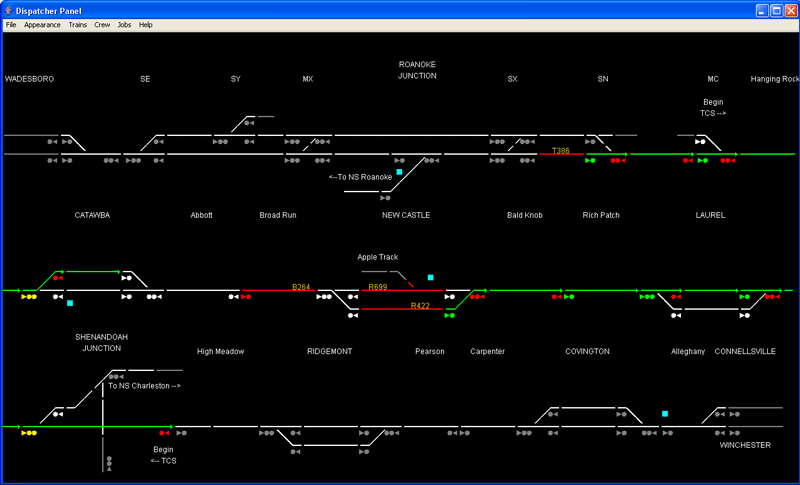TCS Installation Continues on the Shenandoah Division
As mentioned in the 12/11/2005 Progress Report, management has authorized the installation of Traffic Control System (TCS)
on the Shenandoah Division. Since that progress report, the signal maintainers
have continued northward from Catawba with the installation of switch motors and
signals to allow the train dispatcher to authorize traffic movement via TCS.
The signal maintainers worked steadily northward. They began their work by
concentrating on the installation of switch motors and signals at the various OS
sections (control points) at the ends of passing sidings. From December 14
through December 26, 2005, the switch motors and signals were installed at the
south end (SE) of New Castle, the north end (NE) of New Castle, SE Laurel, and
NE Laurel. With these installations completed, the signal maintainers then
installed the intermediate signals at Abbott and Rich Patch.
Realizing that a DTC block would be required between the yard limits of the
Salem Terminal and SE Catawba, management directed the signal maintainers to
install the second SE8C control panel below MC Cabin, as well as the switch
motor and signals for MC Cabin. This work was done on December 29, 2005, and
with its completion, the mainline of the Covington Subdivision was under TCS
control from MC Cabin north to NE Laurel.
Management then authorized the signal maintainers to install the switch motor
and signals at the NS connection track located at Shenandoah Junction. The CSXT
SD Dispatcher Jacksonville will now be able to control the railroad via TCS from
MC Cabin to Shenandoah Junction. DTC rules are still in effect from Shenandoah
Junction to the north end of the Covington Subdivision, and yard limits apply
from MC Cabin south through the Salem Terminal.
The chief signal engineer then defined all of the switch motor and signal
addresses in the configuration file for the CATS dispatcher panel, and ran some
functional tests of the newly installed TCS system.
Three of the operating crew members came over on January 5, 2006 to assist
with a system test of the newly installed TCS components. Three trains were run
continuously over the layout, and the signal system worked quite well.
Future plans are to extend TCS northward to NE Covington.
|
|
Photos of Progress as of January 16, 2006 |

The CATS panel for the Shenandoah Division showing TCS territory from MC
Cabin to Shenandoah Junction. The dispatcher can throw switches remotely
from this panel and feedback is returned to indicate the position of the
switch. When the dispatcher clears a route, the appropriate commands are
sent to signals located on the layout. As a visual cue to the dispatcher,
the "brighter" white signals indicate an actual signal on the layout, while
the gray signals indicate virtual signals (not on layout) for DTC territory.
|

This SE8C is mounted underneath the north end of Catawba. This panel
controls seven switch motors and eight sets of signal heads (32 heads in
all) from SE Catawba to Shenandoah Junction. The gray 10 wire cables coming
into the board on the left hand side of the picture are the "plug and play"
signal buses. The wires going to terminal strips on the right hand side are
the switch motor control and feedback wires.
|

The second SE8C is located under MC Cabin. Currently, the only switch
motor and signals it controls are located at MC Cabin as well. Eventually,
this board will control Ridgemont and portions of the Salem Terminal.
|

Signals and switch motor (Tortoise) installed at MC Cabin. Digitrax SMBK
signals are being used temporarily on the Shenandoah Division until
appropriate color light signals are manufactured in the future. Black
electrical tape has been wrapped around heads on the SMBK signals to prevent
those aspects from showing as a result of the way the Digitrax signaling
system (and SMBK) is configured. "Real" signals will not have this issue as
they will only have the appropriate head.
|

Intermediate signals at Abbott, Va.
|

The B264 pushers on the right are waiting for the dispatcher to give them
permission to pass the stop signal at SE New Castle so they can couple onto
the rear of northbound R422 to shove it up Rich Patch Mountain. Southbound
train R699 is holding back of the stop signal.
|

Signals at NE New Castle. In order to extend above the track more
prototypically, the Digitrax SMBK signal boards would require a 5/8" hole to
be drilled because of the width of the bottom portion of the board (seen in
other photos). For the portions of the layout where I have scenery, I'm
choosing to drill only a 1/4" hole, which allows the top part of the signal
to extend from underneath the layout. When the future "permanent" signals
are installed, I plan to mount them above the layout and use the 1/4" hole
to run the wires below to the SMBK boards, similar to the article by Kent
Williams in the November/December 2004 issue of N Scale Railroading.
By bulletin definition, all signals located on passing sidings, such as the
one immediately to the left of the CSX SD40-2, are dwarf signals. All other
signals are high (or mast) signals, following Clinchfield Railroad
practices.
|

Intermediate signals at Rich Patch, Va.
|

Signal installation at SE Laurel.
|

Signals and switch motor at NE Laurel. The signals can be mounted higher
on the portions of the layout which don't have scenery, since I use a
homemade bracket to mount the SMBK boards.
|

Current north end of TCS at Shenandoah Junction.
|
This page was last updated on
01/01/11.